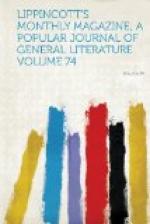The scavenger and the ragpicker, being the lowest grade of blousards, do not always rise to the dignity even of a blouse. They wear a coat sometimes, but it is a marvel of a coat, and was in the last stages of tottering old age before it fell to the blousard. They wear leather boots too sometimes, instead of the wooden shoes belonging to their station, but they are boots which are but a mockery and a delusion, and yield the wearer no comfort. A respectable blousard—a carpenter or a shoemaker or a member of any honest trade—would scorn to be seen in any other dress but his neat blouse, unless on some great day, a fete, his wedding or at church, when he wears his only coat, or his father’s or a friend’s. The blouse is in its sphere a badge of respectability to the wearer, and honest blousards look upon the assumption of a blouse by a thief as a gross imposition upon the public at large and an outrage upon honest workingmen. There is a wide range of quality in blouses, too. I bought one in the Rue Mouffetard, to wear as a protection in some of my night-wanderings, for the sum of forty cents: it was a plain frock of coarse stuff, with a string at the neck. But there were blouses of several degrees of fineness in the shop—some of very fine linen, tied with a white silk ribbon, and neatly embroidered. The usual color of blouses is white, blue or black. The material is often a coarse, warm cloth, such as one might make a very respectable overcoat of, I should think. In cold weather it is common to see men wearing two or even three blouses, one over the other. Caps are sold at from twenty to sixty cents each in the same street. It will be seen that clothing is inexpensive to the blousard, and as the fashions never change with him, he never lays aside a garment till it is quite worn out.




